Artemether and lumefantrin
{{DrugProjectFormSinglePage |authorTag=Alberto Plate [1] |genericName=Artemether |aOrAn=an |drugClass=antimanlaric |indicationType=treatment |indication=acute, uncomplicated malaria infections due to Plasmodium falciparum in patients of 5 kg bodyweight and above |adverseReactions=headache, anorexia, dizziness, asthenia, arthralgia and myalgia |blackBoxWarningTitle=TITLE |blackBoxWarningBody=Condition Name: (Content) |offLabelAdultGuideSupport=There is limited information regarding Off-Label Guideline-Supported Use of Artemether and lumefantrin in adult patients. |offLabelAdultNoGuideSupport=There is limited information regarding Off-Label Non–Guideline-Supported Use of Artemether and lumefantrin in adult patients. |offLabelPedGuideSupport=There is limited information regarding Off-Label Guideline-Supported Use of Artemether and lumefantrin in pediatric patients. |offLabelPedNoGuideSupport=There is limited information regarding Off-Label Non–Guideline-Supported Use of Artemether and lumefantrin in pediatric patients. |contraindications=====Hypersensitivity====
- Known hypersensitivity to artemether, lumefantrine, or to any of the excipients of Coartem Tablets.
Strong CYP3A4 Inducers
- Co-administration of strong inducers of CYP3A4 such as rifampin, carbamazepine, phenytoin and St. John's wort with Coartem Tablets can result in decreased concentrations of artemether and/or lumefantrine and loss of antimalarial efficacy.
|warnings=====Prolongation of the QT Interval==== Some antimalarials (e.g., halofantrine, quinine, quinidine) including Coartem Tablets have been associated with prolongation of the QT interval on the electrocardiogram. Coartem Tablets should be avoided in patients:
- With congenital prolongation of the QT interval (e.g., long QT syndrome) or any other clinical condition known to prolong the QTc interval such as patients with a history of symptomatic cardiac arrhythmias, with clinically relevant bradycardia or with severe cardiac disease.
- With a family history of congenital prolongation of the QT interval or sudden death.
- With known disturbances of electrolyte balance, e.g., hypokalemia or hypomagnesemia.
- Receiving other medications that prolong the QT interval, such as class IA (quinidine, procainamide, disopyramide), or class III (amiodarone, sotalol) antiarrhythmic agents; antipsychotics (pimozide, ziprasidone); antidepressants; certain antibiotics (macrolide antibiotics, fluoroquinolone antibiotics, imidazole, and triazole antifungal agents).
- Receiving medications that are metabolized by the cytochrome enzyme CYP2D6 which also have cardiac effects (e.g., flecainide, imipramine, amitriptyline, clomipramine).
Use of QT Prolonging Drugs and Other Antimalarials
- Halofantrine and Coartem Tablets should not be administered within one month of each other due to the long elimination half-life of lumefantrine (3-6 days) and potential additive effects on the QT interval.
- Antimalarials should not be given concomitantly with Coartem Tablets, unless there is no other treatment option, due to limited safety data.
- Drugs that prolong the QT interval, including antimalarials such as quinine and quinidine, should be used cautiously following Coartem Tablets, due to the long elimination half-life of lumefantrine (3-6 days) and the potential for additive effects on the QT interval; ECG monitoring is advised if use of drugs that prolong the QT interval is medically required.
- If mefloquine is administered immediately prior to Coartem Tablets there may be a decreased exposure to lumefantrine, possibly due to a mefloquine-induced decrease in bile production. Therefore, patients should be monitored for decreased efficacy and food consumption should be encouraged while taking Coartem Tablets.
Drug Interactions with CYP3A4
- When Coartem Tablets are co-administered with substrates of CYP3A4 it may result in decreased concentrations of the substrate and potential loss of substrate efficacy. When Coartem Tablets are co-administered with an inhibitor of CYP3A4, including grapefruit juice it may result in increased concentrations of artemether and/or lumefantrine and potentiate QT prolongation. When Coartem Tablets are co-administered with inducers of CYP3A4 it may result in decreased concentrations of artemether and/or lumefantrine and loss of antimalarial efficacy.
- Drugs that have a mixed effect on CYP3A4, especially antiretroviral drugs such as HIV protease inhibitors and non-nucleoside reverse transcriptase inhibitors, and those that have an effect on the QT interval should be used with caution in patients taking Coartem Tablets.
- Coartem Tablets may reduce the effectiveness of hormonal contraceptives. Therefore, patients using oral, transdermal patch, or other systemic hormonal contraceptives should be advised to use an additional non-hormonal method of birth control.
Drug Interactions with CYP2D6
- Administration of Coartem Tablets with drugs that are metabolized by CYP2D6 may significantly increase plasma concentrations of the co-administered drug and increase the risk of adverse effects. Many of the drugs metabolized by CYP2D6 can prolong the QT interval and should not be administered with Coartem Tablets due to the potential additive effect on the QT interval (e.g., flecainide, imipramine, amitriptyline, clomipramine).
Recrudescence
- Food enhances absorption of artemether and lumefantrine following administration of Coartem Tablets.
- Patients who remain averse to food during treatment should be closely monitored as the risk of recrudescence may be greater. In the event of recrudescent P. falciparum infection after treatment with Coartem Tablets, patients should be treated with a different antimalarial drug.
Hepatic and Renal Impairment
- Coartem Tablets have not been studied for efficacy and safety in patients with severe hepatic and/or renal impairment.
Plasmodium vivax Infection
- Coartem Tablets have been shown in limited data (43 patients) to be effective in treating the erythrocytic stage of P. vivax infection. However, relapsing malaria caused by P. vivax requires additional treatment with other antimalarial agents to achieve radical cure i.e., eradicate any hypnozoites forms that may remain dormant in the liver.
|clinicalTrials=====Serious Adverse Reactions==== The following serious and otherwise important adverse reactions are discussed in greater detail in other sections of labeling:
Clinical Studies Experience
Because clinical trials are conducted under widely varying conditions, adverse reaction rates observed in the clinical trials of a drug cannot be directly compared to rates in the clinical trials of another drug and may not reflect the rate observed in practice.
The data described below reflect exposure to a 6-dose regimen of Coartem Tablets in 1,979 patients including 647 adults (older than 16 years) and 1,332 children (16 years and younger). For the 6-dose regimen, Coartem Tablets was studied in active-controlled (366 patients) and non-controlled, open-label trials (1,613 patients). The 6-dose Coartem Tablets population was patients with malaria between ages 2 months and 71 years: 67% (1,332) were 16 years and younger and 33% (647) were older than 16 years. Males represented 73% and 53% of the adult and pediatric populations, respectively. The majority of adult patients were enrolled in studies in Thailand, while the majority of pediatric patients were enrolled in Africa.
Tables 1 and 2 show the most frequently reported adverse reactions (вЙ•3%) in adults and children respectively who received the 6-dose regimen of Coartem Tablets. Adverse reactions collected in clinical trials included signs and symptoms at baseline but only treatment emergent adverse events, defined as events that appeared or worsened after the start of treatment, are presented below. In adults, the most frequently reported adverse reactions were headache, anorexia, dizziness, and asthenia. In children, the adverse reactions were pyrexia, cough, vomiting, anorexia, and headache. Most adverse reactions were mild, did not lead to discontinuation of study medication, and resolved.
In limited comparative studies, the adverse reaction profile of Coartem Tablets appeared similar to that of another antimalarial regimen.
Discontinuation of Coartem Tablets due to adverse drug reactions occurred in 1.1% of patients treated with the 6-dose regimen overall: 0.2% (1/647) in adults and 1.6% (21/1,332) in children.

Clinically significant adverse reactions reported in adults and/or children treated with the 6-dose regimen of Coartem Tablets which occurred in clinical studies at <3% regardless of causality are listed below:
- Blood and lymphatic system disorders: eosinophilia
- Ear and labyrinth disorders: tinnitus
- Eye disorders: conjunctivitis
- Gastrointestinal disorders: constipation, dyspepsia, dysphagia, peptic ulcer
- General disorders: gait disturbance
- Infections and infestations: abscess, acrodermatitis, bronchitis, ear infection, gastroenteritis, helminthic infection, hookworm infection, impetigo, influenza, lower respiratory tract infection, malaria, nasopharyngitis, oral herpes, pneumonia, respiratory tract infection, subcutaneous abscess, upper respiratory tract infection, urinary tract infection
- Investigations: alanine aminotransferase increased, aspartate aminotransferase increased, hematocrit decreased, lymphocyte morphology abnormal, platelet count decreased, platelet count increased, white blood cell count decreased, white blood cell count increased
- Metabolism and nutrition disorders: hypokalemia
- Musculoskeletal and connective tissue disorders: back pain
- Nervous system disorders: ataxia, clonus, fine motor delay, hyperreflexia, hypoaesthesia, nystagmus, tremor.
- Psychiatric disorders: agitation, mood swings
- Renal and urinary disorders: hematuria, proteinuria
- Respiratory, thoracic and mediastinal disorders: asthma, pharyngo-laryngeal pain
- Skin and subcutaneous tissue disorders: urticaria
|postmarketing=The following adverse reactions have been identified during post-approval use of Coartem Tablets. Because these events are reported voluntarily from a population of uncertain size, it is not always possible to reliably estimate their frequency or establish a causal relationship to drug exposure.
- Hypersensitivity reactions including urticaria and angioedema. Serious skin reactions (bullous eruption) have been rarely reported.
|drugInteractions=====Rifampin====
- Oral administration of rifampin, a strong CYP3A4 inducer, with Coartem Tablets resulted in significant decreases in exposure to artemether, dihydroartemisinin (DHA, metabolite of artemether) and lumefantrine by 89%, 85% and 68%, respectively, when compared to exposure values after Coartem Tablets alone. Concomitant use of strong inducers of CYP3A4 such as rifampin, carbamazepine, phenytoin and St. John's wort is contraindicated with Coartem Tablets.
Ketoconazole
- Concurrent oral administration of ketoconazole, a potent CYP3A4 inhibitor, with a single dose of Coartem Tablets resulted in a moderate increase in exposure to artemether, DHA, and lumefantrine in a study of 15 healthy subjects. No dose adjustment of Coartem Tablets is necessary when administered with ketoconazole or other potent CYP3A4 inhibitors. However, due to the potential for increased concentrations of lumefantrine which could lead to QT prolongation, Coartem Tablets should be used cautiously with drugs that inhibit CYP3A4.
Antiretroviral Drugs
- Both artemether and lumefantrine are metabolized by CYP3A4. Antiretroviral drugs, such as protease inhibitors and non-nucleoside reverse transcriptase inhibitors, are known to have variable patterns of inhibition, induction or competition for CYP3A4. Therefore, the effects of antiretroviral drugs on the exposure to artemether, DHA, and lumefantrine are also variable [see Clinical Pharmacology (12.3)]. Coartem Tablets should be used cautiously in patients on antiretroviral drugs because decreased artemether, DHA, and/or lumefantrine concentrations may result in a decrease of antimalarial efficacy of Coartem Tablets, and increased lumefantrine concentrations may cause QT prolongation.
Prior Use of Mefloquine
- Administration of three doses of mefloquine followed 12 hours later by a 6-dose regimen of Coartem Tablets in 14 healthy volunteers demonstrated no effect of mefloquine on plasma concentrations of artemether or the artemether/DHA ratio. However, exposure to lumefantrine was reduced, possibly due to lower absorption secondary to a mefloquine-induced decrease in bile production. Patients should be monitored for decreased efficacy and food consumption should be encouraged with administration of Coartem Tablets.
Hormonal Contraceptives
- In vitro, the metabolism of ethinyl estradiol and levonorgestrel was not induced by artemether, DHA, or lumefantrine. However, artemether has been reported to weakly induce, in humans, the activity of CYP2C19, CYP2B6, and CYP3A. Therefore, Coartem Tablets may potentially reduce the effectiveness of hormonal contraceptives. Patients using oral, transdermal patch, or other systemic hormonal contraceptives should be advised to use an additional non-hormonal method of birth control.
CYP2D6 Substrates
- Lumefantrine inhibits CYP2D6 in vitro. Administration of Coartem Tablets with drugs that are metabolized by CYP2D6 may significantly increase plasma concentrations of the co-administered drug and increase the risk of adverse effects. Many of the drugs metabolized by CYP2D6 can prolong the QT interval and should not be administered with Coartem Tablets due to the potential additive effect on the QT interval (e.g., flecainide, imipramine, amitriptyline, clomipramine)
Sequential Use of Quinine
- A single dose of intravenous quinine (10 mg/kg bodyweight) concurrent with the final dose of a 6-dose regimen of Coartem Tablets demonstrated no effect of intravenous quinine on the systemic exposure of DHA or lumefantrine. Quinine exposure was also not altered. Exposure to artemether was decreased. This decrease in artemether exposure is not thought to be clinically significant. However, quinine and other drugs that prolong the QT interval should be used cautiously following treatment with Coartem Tablets due to the long elimination half-life of lumefantrine and the potential for additive QT effects; ECG monitoring is advised if use of drugs that prolong the QT interval is medically required.
Interaction with Drugs that are Known to Prolong the QT Interval
- Coartem is to be used with caution when co-administered with drugs that may cause prolonged QT interval such as antiarrhythmics of classes IA and III, neuroleptics and antidepressant agents, certain antibiotics including some agents of the following classes: macrolides, fluoroquinolones, imidazole, and triazole antifungal agents.
|FDAPregCat=C |useInPregnancyFDA=Safety data from an observational pregnancy study of approximately 500 pregnant women who were exposed to Coartem Tablets (including a third of patients who were exposed in the first trimester), and published data of over 1,000 pregnant patients who were exposed to artemisinin derivatives, did not show an increase in adverse pregnancy outcomes or teratogenic effects over background rate.
The efficacy of Coartem Tablets in the treatment of acute, uncomplicated malaria in pregnant women has not been established.
Coartem Tablets should be used during pregnancy only if the potential benefit justifies the potential risk to the fetus.
Pregnant rats dosed during the period of organogenesis at or higher than a dose of about half the highest clinical dose of 1120 mg artemether-lumefantrine per day (based on body surface area comparisons), showed increases in fetal loss, early resorptions and post implantation loss. No adverse effects were observed in animals dosed at about one-third the highest clinical dose. Similarly, dosing in pregnant rabbits at about three times the clinical dose (based on body surface area comparisons) resulted in abortions, preimplantation loss, post implantation loss and decreases in the number of live fetuses. No adverse reproductive effects were detected in rabbits at two times the clinical dose. Embryo-fetal loss is a significant reproductive toxicity. Other artemisinins are known to be embryotoxic in animals. However, because metabolic profiles in animals and humans are dissimilar, artemether exposures in animals may not be predictive of human exposures [see Nonclinical Toxicology (13.2)]. These data cannot rule out an increased risk for early pregnancy loss or fetal defects in humans. |useInNursing=It is not known whether artemether or lumefantrine is excreted in human milk. Because many drugs are excreted in human milk, caution should be exercised when Coartem Tablets are administered to a nursing woman. Animal data suggest both artemether and lumefantrine are excreted into breast milk. The benefits of breastfeeding to mother and infant should be weighed against potential risk from infant exposure to artemether and lumefantrine through breast milk. |useInPed=The safety and effectiveness of Coartem Tablets have been established for the treatment of acute, uncomplicated malaria in studies involving pediatric patients weighing 5 kg or more [see Clinical Studies (14.1)]. The safety and efficacy have not been established in pediatric patients who weigh less than 5 kg. Children from non-endemic countries were not included in clinical trials. |useInGeri=Clinical studies of Coartem Tablets did not include sufficient numbers of subjects aged 65 years and over to determine they respond differently from younger subjects. In general, the greater frequency of decreased hepatic, renal, or cardiac function, and of concomitant disease or other drug therapy in elderly patients should be considered when prescribing Coartem Tablets. |useInRenalImpair=No specific pharmacokinetic studies have been performed in patients with either hepatic or renal impairment. Coartem Tablets have not been studied for efficacy and safety in patients with severe hepatic and/or renal impairment. Based on the pharmacokinetic data in 16 healthy subjects showing no or insignificant renal excretion of lumefantrine, artemether and DHA, no dose adjustment for the use of Coartem in patients with renal impairment is advised. No dosage adjustment is necessary in patients with mild to moderate hepatic impairment [see Dosage and Administration (2.4) and Warnings and Precautions (5.6)]. |useInHepaticImpair=No specific pharmacokinetic studies have been performed in patients with either hepatic or renal impairment. Coartem Tablets have not been studied for efficacy and safety in patients with severe hepatic and/or renal impairment. Based on the pharmacokinetic data in 16 healthy subjects showing no or insignificant renal excretion of lumefantrine, artemether and DHA, no dose adjustment for the use of Coartem in patients with renal impairment is advised. No dosage adjustment is necessary in patients with mild to moderate hepatic impairment [see Dosage and Administration (2.4) and Warnings and Precautions (5.6)]. |overdose=*There is no information on overdoses of Coartem Tablets higher than the doses recommended for treatment.
- In cases of suspected overdosage, symptomatic and supportive therapy, which would include ECG and blood electrolyte monitoring, should be given as appropriate.
|drugBox=
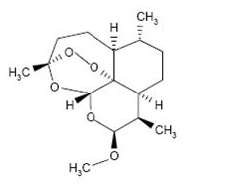
| |
Artemether and lumefantrin
| |
| Systematic (IUPAC) name | |
| (3R,5aS,6R,8aS,9R,10S,12R,12aR)-10-methoxy-3,6,9-trimethyldecahydro-12H-3,12-epoxy[1,2]dioxepino[4,3-i]-2-benzopyran | |
| Identifiers | |
| CAS number | |
| ATC code | P01 |
| PubChem | |
| DrugBank | |
| Chemical data | |
| Formula | Template:OrganicBox atomTemplate:OrganicBox atomTemplate:OrganicBoxTemplate:OrganicBoxTemplate:OrganicBoxTemplate:OrganicBoxTemplate:OrganicBoxTemplate:OrganicBoxTemplate:OrganicBoxTemplate:OrganicBoxTemplate:OrganicBoxTemplate:OrganicBoxTemplate:OrganicBoxTemplate:OrganicBoxTemplate:OrganicBoxTemplate:OrganicBox atomTemplate:OrganicBoxTemplate:OrganicBoxTemplate:OrganicBoxTemplate:OrganicBoxTemplate:OrganicBoxTemplate:OrganicBoxTemplate:OrganicBox |
| Mol. mass | 298.374 g/mol |
| SMILES | & |
| Pharmacokinetic data | |
| Bioavailability | ? |
| Metabolism | ? |
| Half life | ? |
| Excretion | ? |
| Therapeutic considerations | |
| Pregnancy cat. |
C(US) |
| Legal status | |
| Routes | Oral |
|mechAction=Coartem Tablets, a fixed dose combination of artemether and lumefantrine in the ratio of 1:6, is an antimalarial agent. Artemether is rapidly metabolized into an active metabolite dihydroartemisinin (DHA). The antimalarial activity of artemether and DHA has been attributed to endoperoxide moiety. The exact mechanism by which lumefantrine, exerts its antimalarial effect is not well defined. Available data suggest lumefantrine inhibits the formation of ќ≤-hematin by forming a complex with hemin. Both artemether and lumefantrine were shown to inhibit nucleic acid and protein synthesis. |structure=Artemether has the empirical formula C16H26O5 with a molecular weight of 298.4, and the following structural formula:

Lumefantrin has the empirical formula C30H32Cl3NO with a molecular weight of 528.9, and the following structural formula:
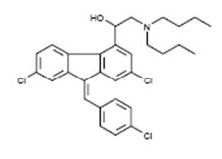
|PK=====Absorption====
- Following administration of Coartem Tablets to healthy volunteers and patients with malaria, artemether is absorbed with peak plasma concentrations reached about 2 hours after dosing. Absorption of lumefantrine, a highly lipophilic compound, starts after a lag-time of up to 2 hours, with peak plasma concentrations about 6 to 8 hours after administration. The single dose (4 tablets) pharmacokinetic parameters for artemether, dihydroartemisinin (DHA), an active antimalarial metabolite of artemether, and lumefantrine in adult Caucasian healthy volunteers are given in Table 3. Multiple dose data after the 6-dose regimen of Coartem Tablets in adult malaria patients are given in Table 4.
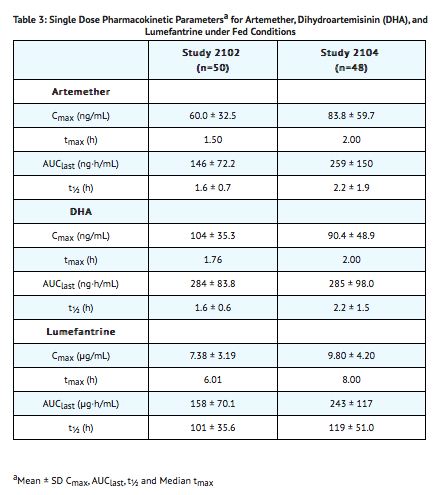
- Food enhances the absorption of both artemether and lumefantrine. In healthy volunteers, the relative bioavailability of artemether was increased between two- to three-fold, and that of lumefantrine sixteen-fold when Coartem Tablets were taken after a high-fat meal compared under fasted conditions. Patients should be encouraged to take Coartem Tablets with a meal as soon as food can be tolerated.
Distribution
- Artemether and lumefantrine are both highly bound to human serum proteins in vitro (95.4% and 99.7%, respectively). Dihydroartemisinin is also bound to human serum proteins (47% to 76%). Protein binding to human plasma proteins is linear.
Biotransformation
- In human liver microsomes and recombinant CYP450 enzymes, the metabolism of artemether was catalyzed predominantly by CYP3A4/CYP3A5. Dihydroartemisinin (DHA) is an active metabolite of artemether. The metabolism of artemether was also catalyzed to a lesser extent by CYP2B6, CYP2C9 and CYP2C19. In vitro studies with artemether at therapeutic concentrations revealed no significant inhibition of the metabolic activities of CYP1A2, CYP2A6, CYP2C9, CYP2C19, CYP2D6, CYP2E1, CYP3A4/CYP3A5, and CYP4A9/CYP3A11. In vitro studies with artemether, DHA, and lumefantrine at therapeutic concentrations revealed no significant induction of the metabolic activities of CYP1A1, CYP1A2, CYP2B6, CYP2C8, CYP2C9, CYP2C19, CYP3A4, or CYP3A5.
- During repeated administration of Coartem Tablets, systemic exposure of artemether decreased significantly, while concentrations of DHA increased, although not to a statistically significant degree. The artemether/DHA AUC ratio is 1.2 after a single dose and 0.3 after 6 doses given over 3 days. This suggests that there was induction of enzymes responsible for the metabolism of artemether.
- In human liver microsomes and in recombinant CYP450 enzymes, lumefantrine was metabolized mainly by CYP3A4 to desbutyl-lumefantrine. The systemic exposure to the metabolite desbutyl-lumefantrine was less than 1% of the exposure to the parent compound. In vitro, lumefantrine significantly inhibits the activity of CYP2D6 at therapeutic plasma concentrations.
- Caution is recommended when combining Coartem Tablets with substrates, inhibitors, or inducers of CYP3A4, especially antiretroviral drugs and those that prolong the QT interval (e.g., macrolide antibiotics, pimozide).
- Co-administration of Coartem Tablets with CYP2D6 substrates may result in increased plasma concentrations of the CYP2D6 substrate and increase the risk of adverse reactions. In addition, many of the drugs metabolized by CYP2D6 can prolong the QT interval and should not be administered with Coartem Tablets due to the potential additive effect on the QT interval (e.g., flecainide, imipramine, amitriptyline, clomipramine).
Elimination
- Artemether and DHA are cleared from plasma with an elimination half-life of about 2 hours. Lumefantrine is eliminated more slowly, with an elimination half-life of 3-6 days in healthy volunteers and in patients with falciparum malaria. Demographic characteristics such as sex and weight appear to have no clinically relevant effects on the pharmacokinetics of artemether and lumefantrine.
- In 16 healthy volunteers, neither lumefantrine nor artemether was found in the urine after administration of Coartem, and urinary excretion of DHA amounted to less than 0.01% of the artemether dose.
Pharmacokinetics in Special Population
Hepatic and Renal Impairment
- No specific pharmacokinetic studies have been performed in patients with either hepatic or renal impairment.
- There is no significant renal excretion of lumefantrine, artemether and DHA in healthy volunteers and while clinical experience in this population is limited, no dose adjustment in renal impairment is recommended.
Pediatric Patients=
- The PK of artemether, DHA, and lumefantrine were obtained in two pediatric studies by sparse sampling using a population based approach. PK estimates derived from a composite plasma concentration profile for artemether, DHA, and lumefantrine are provided in Table 4.
- Systemic exposure to artemether, DHA, and lumefantrine, when dosed on a mg/kg body weight basis in pediatric patients (вЙ•5 to <35 kg body weight), is comparable to that of the recommended dosing regimen in adult patients.
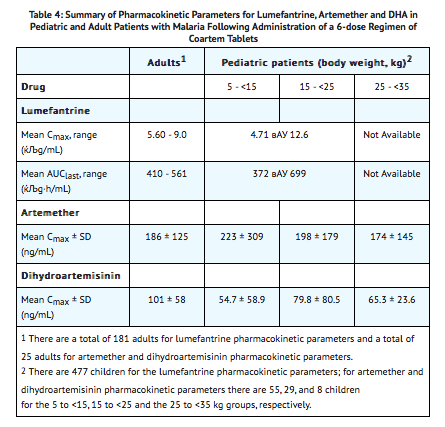
Geriatric Patients
No specific pharmacokinetic studies have been performed in patients older than 65 years of age. |nonClinToxic====Carcinogenesis, Mutagenesis, Impairment of Fertility===
Carcinogenesis
- Carcinogenicity studies were not conducted.
Mutagenesis
- No evidence of mutagenicity was detected. The artemether: lumefantrine combination was evaluated using the Salmonella and Escherichia/mammalian-microsome mutagenicity test, the gene mutation test with Chinese hamster cells V79, the cytogenetic test on Chinese hamster cells in vitro, and the rat micronucleus test, in vivo.
Impairment of Fertility
- Pregnancy rates were reduced by about one half in female rats dosed for 2 to 4 weeks with the artemether-lumefantrine combination at 1000 mg/kg (about 9 times the clinical dose based on body surface area comparisons). Male rats dosed for 70 days showed increases in abnormal sperm (87% abnormal) and increased testes weights at 30 mg/kg doses (about one third the clinical dose). Higher doses (about 9 times the clinical dose) resulted in decreased sperm motility and 100% abnormal sperm cells.
Animal Toxicology and/or Pharmacology
Neonatal rats (7-21 days old) were more sensitive to the toxic effects of artemether (a component of Coartem) than older juvenile rats or adults. Mortality and severe clinical signs were observed in neonatal rats at doses which were well tolerated in pups above 22 days old. |clinicalStudies====Treatment of Acute, Uncomplicated P. falciparum Malaria=== The efficacy of Coartem Tablets was evaluated for the treatment of acute, uncomplicated malaria caused by P. falciparum in HIV negative patients in 8 clinical studies. Uncomplicated [[m++alaria was defined as symptomatic P. falciparum malaria without signs and symptoms of severe malaria or evidence of vital organ dysfunction. Baseline parasite density ranged from 500/µL - 200,000/µL (0.01% to 4% parasitemia) in the majority of patients. Studies were conducted in partially immune and non-immune adults and children (вЙ•5kg body weight) with uncomplicated malaria in China, Thailand, sub-Saharan Africa, Europe, and South America. Patients who had clinical features of severe malaria, severe cardiac, renal, or hepatic impairment were excluded.
The studies include two 4-dose studies assessing the efficacy of the components of the regimen, a study comparing a 4-dose versus a 6-dose regimen, and 5 additional 6-dose regimen studies.
Coartem Tablets were administered at 0, 8, 24, and 48 hours in the 4-dose regimen, and at 0, 8, 24, 36, 48, and 60 hours in the 6-dose regimen. Efficacy endpoints consisted of:
- 28 day cure rate, defined as clearance of asexual parasites (the erythrocytic stage) within 7 days without recrudescence by day 28
- parasite clearance time (PCT), defined as time from first dose until first total and continued disappearance of asexual parasite which continues for a further 48 hours
- fever clearance time (FCT), defined as time from first dose until the first time body temperature fell below 37.5°C and remained below 37.5°C for at least a further 48 hours (only for patients with temperature >37.5°C at baseline)
The modified intent to treat (mITT) population includes all patients with malaria diagnosis confirmation who received at least one dose of study drug. Evaluable patients generally are all patients who had a day 7 and a day 28 parasitological assessment or experienced treatment failure by day 28.
Studies 1 and 2: The two studies which assessed the efficacy of Coartem Tablets (4 doses of 4 tablets of 20 mg artemether/120 mg lumefantrine) compared to each component alone were randomized, double-blind, comparative, single center, conducted in China. The efficacy results (Table 5) support that the combination of artemether and lumefantrine in Coartem Tablets had a significantly higher 28-day cure rate compared to artemether and had a significantly faster parasite clearance time (PCT) and fever clearance time (FCT) compared to lumefantrine.
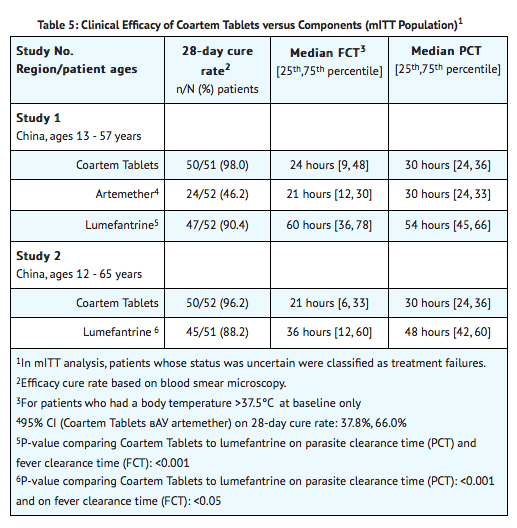
Results of 4-dose studies conducted in areas with high resistance such as Thailand during 1995-96 showed lower efficacy results than the above studies. Therefore, Study 3 was conducted.
Study 3: Study 3 was a randomized, double-blind, two-center study conducted in Thailand in adults and children (aged вЙ•2 years), which compared the 4-dose regimen (administered over 48 hours) of Coartem Tablets to a 6-dose regimen (administered over 60 hours). Twenty-eight day cure rate in mITT subjects was 81% (96/118) for the Coartem Tablets 6-dose arm as compared to 71% (85/120) in the 4-dose arm.
Studies 4, 5, 6, 7, and 8: In these studies, Coartem Tablets were administered as the 6-dose regimen.
- In study 4, a total of 150 adults and children aged вЙ•2 years received Coartem Tablets. In study 5, a total 164 adults and children вЙ•12 years received Coartem Tablets. Both studies were conducted in Thailand.
- Study 6 was a study of 165 non-immune adults residing in regions non-endemic for malaria (Europe and Colombia) who contracted acute uncomplicated falciparum malaria when traveling in endemic regions.
- Study 7 was conducted in Africa in 310 infants and children aged 2 months to 9 years, weighing 5 kg to 25 kg, with an axillary temperature вЙ•37.5ºC.
- Study 8 was conducted in Africa in 452 infants and children, aged 3 months to 12 years, weighing 5 kg to <35 kg, with fever (вЙ•37.5°C axillary or вЙ•38°C rectally) or history of fever in the preceding 24 hours.
Results of 28-day cure rate, median parasite clearance time (PCT), and fever clearance time (FCT) for Studies 3 to 8 are reported in Table 6.
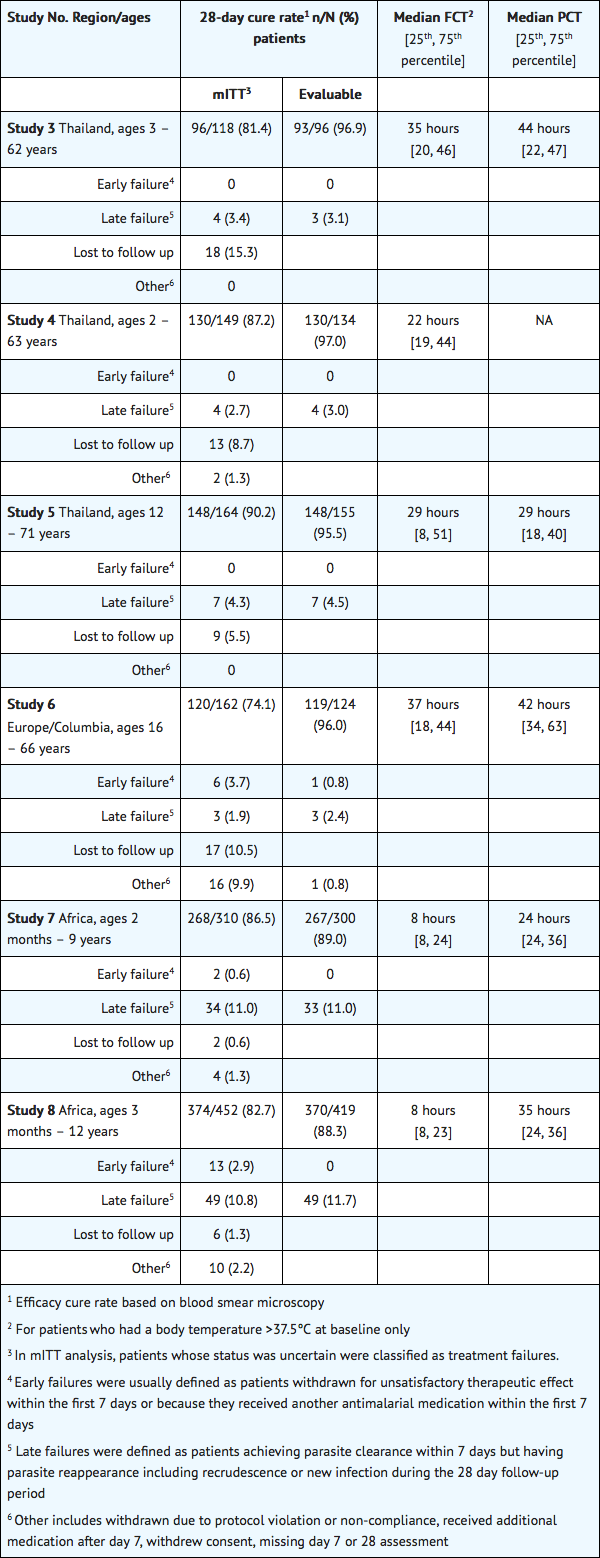
- In all studies, patients’ signs and symptoms of malaria resolved when parasites were cleared.
- In studies conducted in areas with high transmission rates, such as Africa, reappearance of P. falciparum parasites may be due to recrudescence or a new infection.
The efficacy by body weight category for studies 7 and 8 is summarized in Table 7.
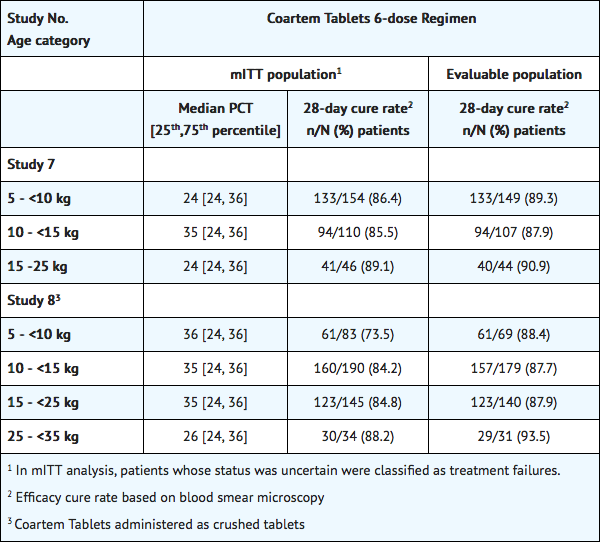
|howSupplied=====Coartem (artemether/lumefantrine) Tablets==== 20 mg/120 mg Tablets - yellow, round flat tablets with beveled edges and scored on one side. Tablets are imprinted with N/C on one side and CG on the other.
- Bottle of 24: NDC 0078-0568-45
|storage=Store at 25ºC (77ºF); excursions permitted to 15-30ºC (59-86ºF)
|packLabel=
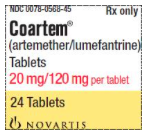
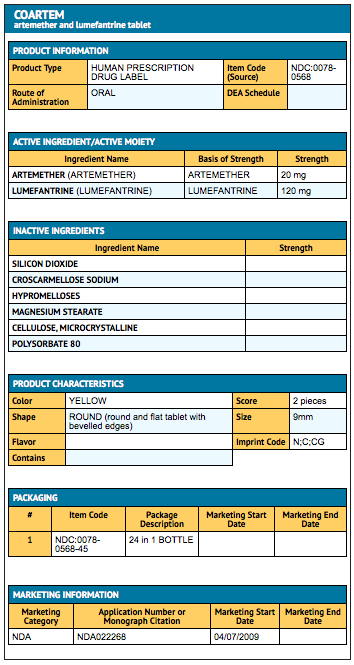
|alcohol=Alcohol-Artemether and lumefantrin interaction has not been established. Talk to your doctor about the effects of taking alcohol with this medication. }}